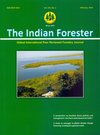Green Approaches and Sustainable Development of Conventional Methods of Bleaching Used in Paper Industry
DOI:
https://doi.org/10.36808/if/2016/v142i2/88800Keywords:
Bleaching, Effluent Loads, Elemental Chlorine Free Bleaching, Absorbable Organic Halogens.Abstract
The objective of the green approaches is to reduce chemical related impact on human health and eliminate contamination of the environment through fully and partially modified the conventional trends used in the bleaching of the pulp. The paper industry has always been associated with the various environmental issues. The pressure on paper industry is more due to discharge of chlorinated organic matter from bleach plant. In conventional bleaching chlorination/alkali extraction/hypochlorite/hypochlorite sequence is generally adopted. The main source of pollutants in chlorination and alkali extraction. The pollutant contribute for Chemical Oxygen Demand (COD), Biological Oxygen Demand (BOD), Toxic Chlorinated Compounds (TOX) and colour. During bleaching of the residual lignin of pulp generate the large amount organic chlorinated compounds in the effluent. The amount of chlorinated compound used for the bleaching of pulp is directly proportional of residual lignin of the pulp. The present study is partially replacement of the elemental chlorine by oxygen or fully replacement of the elemental chlorine by chlorine dioxide and peroxide. Effluent loads from different traditional and emerging ECF bleaching sequences were investigated. Oxygen delignified Eucalyptus tereticornis kraft pulps having similar kappa number 44.91 and 26.46 were used in this study. Different ECF bleaching sequences were compared with reference sequence, C/E/H/H O/C/E/H, O/C/E/H and O/C/E/P in terms of effluent load, such as COD, BOD and AOX. Depending on the nature of sequences 5 50.0% elemental chlorine consumption was reduced and as a result the amount of AOX formation was also reduced.References
Annergren G., Linblad P., Garlsson. G and Norrby M. (1986). In:Proceeding of the EuCePa Symposium on environmental protection p.65
APHA , AWWA and WPCE (1998). Standard Methods for the Examination of Water and Waste water. 20th Edition Washington DC, USA
Bhandari and Bhatnagar (2000) “Oxygen bleaching of E. tereticornis kraft pulps and bleaching effluents characterization†In paper international, 4(4):13-15 July
Bhandari and Bhatnagar (2001). Optimization of oxygen treatment parameters for E. tereticornis kraft pulp†Indian Forester, 127(3): 315-324.
Bjorklund M., Germgard U., Jour P. and Forsstrom A. (2002). “AOX formation in ECF bleaching at different Kappa number influence of oxygen delignificationâ€, Tappi J.,1(7):20.
Bjorklund M., Germgard U. and Basta J. (2004). Formation of AOX and OCI in ECF bleaching of brich pulp, Tappi J.,3(8):7.
Chirat C. (2000). “Environmentally benign approaches for pulp bleachingâ€, In: Proceedings of 53rd ATIP Annual Meeting, 7 (2000).
Chirat C., Lachenal D., Angelier R. and Viardin M. (1997). “ECF Bleaching processâ€, J. Pulp Paper Sci., 23(6): 289.
Homer G., Johnson S. and Epiney M. (1996). In: Proceedings of TAPPI Pulping Conference, 81.
Johnston P.A., Stringer R.L., Santillo D., Stephenson A.D., Labounskaia I.P. and McCartney H.M.A. (1996). Technical report 7/96, Greenpeace Research Laboratories, University of Exeter, UK.
Krringstad K.P. and Lindstrom K. (1984). Environmental science & technology, 18(8):236-A.
Karim M.R. (2006). Doctoral Dissertation, Pulp and Paper Technology Field of Study, Asian Institute of Technology, Thailand.
Downloads
Downloads
Published
How to Cite
Issue
Section
License
Unless otherwise stated, copyright or similar rights in all materials presented on the site, including graphical images, are owned by Indian Forester.





